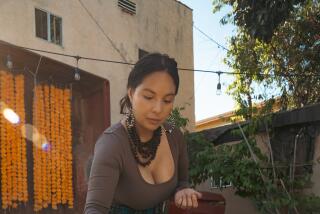Signs of chocolate found in Southwest much earlier
- Share via
Cacao, the staple of Valentine’s Day chocolates and hot drinks by a cozy winter fire, made it to the American Southwest by AD 1000, centuries earlier than researchers had believed.
In a study published Monday, scientists said they had found traces of theobromine, the chemical that serves as a distinct marker for cacao, on pottery shards found in a multistory pueblo in northwestern New Mexico.
Previous studies had not placed cacao in what is now the United States until after the Spanish conquest of South America in the 15th century.
The nearest source for the cacao, which was made into a bitter beverage used in religious and other rituals, was more than 1,200 miles to the south in Mexico.
The new findings were reported in Proceedings of the National Academy of Sciences.
“This should open a much broader discussion about interactions between Mesoamerica and the Southwest,” said archaeologist Keith Prufer of the University of New Mexico, who was not involved in the research. “We’ve had these discussions before, but this presents a new take on it.”
Traces of the cacao were found in shards from cylinder jars found at Pueblo Bonito in Chaco Canyon in northwestern New Mexico. The site was occupied by the Chaco culture for millenniums, but it grew rapidly beginning about AD 900.
The multistory pueblo itself contains an estimated 800 rooms, constructed from 860 to 1128. The site fell into disuse in about 1250.
The cylinders, which are generally about 2 1/2 times as tall as they are wide, are most often painted with black designs on white backgrounds. They are common throughout Central America, where hieroglyphic inscriptions often proclaim the equivalent of “This is Joe’s cacao cup.”
They are quite rare in the Southwest, however. Only about 200 of them have been found in the Pueblo Bonito region -- 111 of them in one room at the pueblo.
Archaeologist Patricia L. Crown of the University of New Mexico has been studying the jars at the site for several years.
When she found some cylinder shards, she took the opportunity to test them, contacting chemist W. Jeffrey Hurst of the Hershey Center for Health and Nutrition in Hershey, Pa.
They scraped the interior of the shards, dissolved the residue in water and analyzed it with a mass chromatograph.
“This tells us that cacao was an exchange item that was coming at least into the Southwest,” Crown said. “That’s one more thing we know was coming from that area.” Other items brought in included copper bells, cloissone enamel and scarlet macaws.
Researchers do not yet know how the Chaco were using the beans, but the concentration of cylinders in one room suggests the use was ceremonial in nature.
“The fact that [the cylinders] are low in numbers and deposited in caches suggests a ritual rather than something one would consume on an everyday basis,” Crown said.
In Central America, where the plant grows under hot and humid conditions, Prufer noted, the beverage was consumed in wedding rituals, in ceremonies marking a change in social or political status and as an offering when people died, among other uses. Users would pour it from one cylinder to another repeatedly to create a highly desirable froth.
It is not hard to believe that the Chaco adopted it for similar purposes, Prufer said.
--






